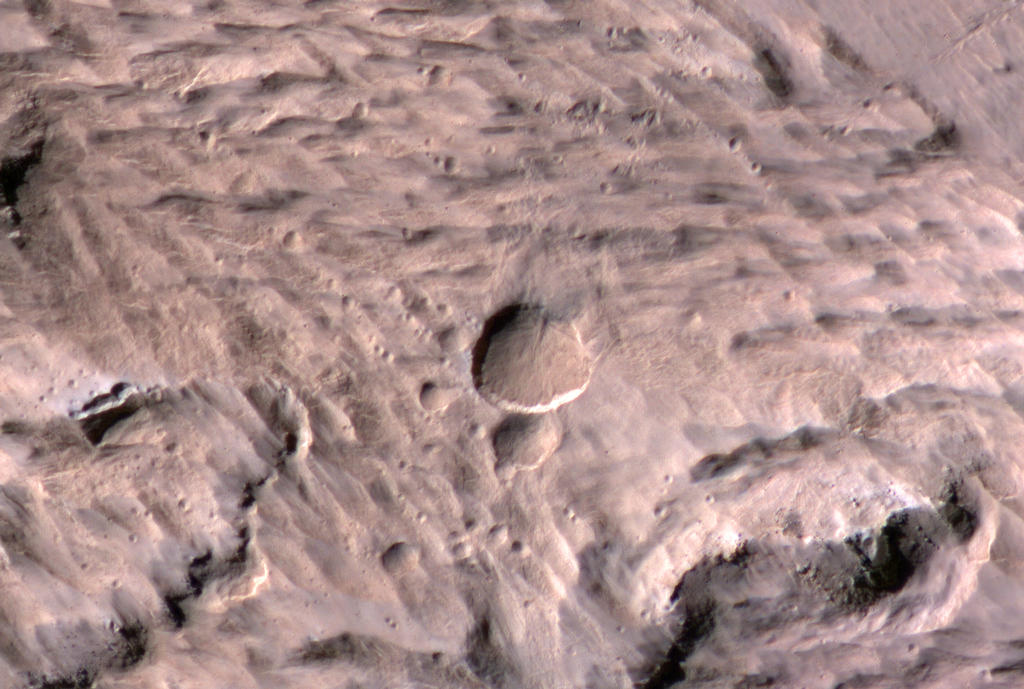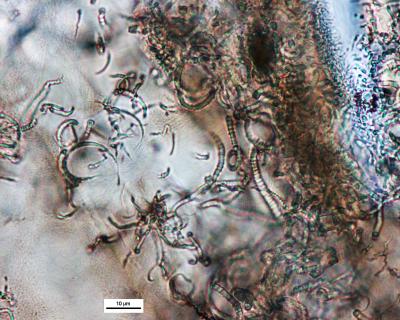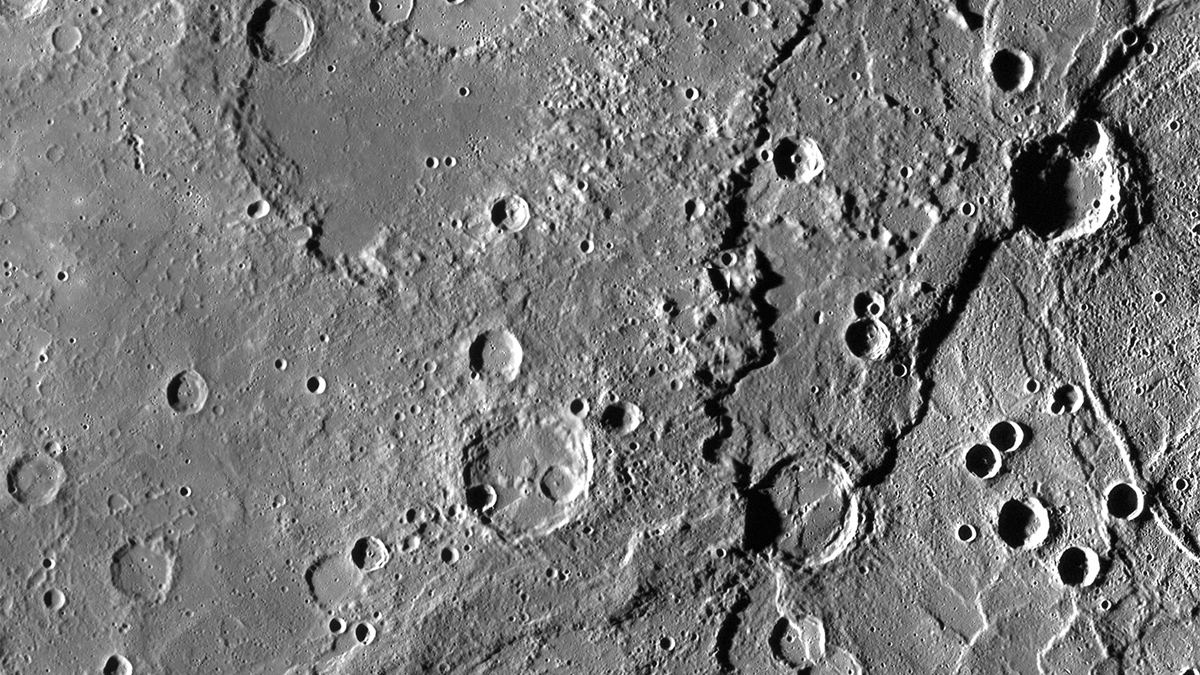Why Alien Life Hunt Should Focus on Impact Craters

Asteroid and comet impacts can trigger widespread havoc, killing off life on a global scale. Now, one new study reveals that the molten wreckage of these explosions can entomb the remains of life that once dwelt in the blast zones and preserve them for millions of years, while another study hints that these impacts could even create novel habitats where life can flourish.
These findings suggest that impact craters on alien worlds might be good places to look for past and present signs of life, researchers say.
The blazing heat generated by cosmic impacts can heat, melt and even vaporize tons of soil and rock, some of which forms glass as it cools. Impact geologist Peter Schultz at Brown University in Providence, Rhode Island, has explored impact glasses in Argentina for more than 20 years. An area roughly the size of Texas in eastern Argentina (south of Buenos Aires) is littered with impact glass created by at least seven different impacts that occurred between 6,000 years ago and 9.2 million years ago. [5 Bold Claims of Alien Life]
"As we collected these glasses, we could see what appeared to be leaf-like materials trapped inside," Schultz said.
He and his colleagues detailed their findings online April 15 in the journal Geology.

Plant material was seen in each impact. In two impacts in particular — one from 3 million years ago and the other from 9 million years ago — Schultz and his colleagues discovered centimeter-size leaf fragments, including structures such as papillae, tiny bumps that line leaf surfaces. Bundles of vein-like structures found in several samples are very similar to modern pampas grass, a species common to that region of Argentina.
"Impact glass may actually trap and preserve remnants of past life," Schultz said.
Breaking space news, the latest updates on rocket launches, skywatching events and more!
The fragile plant matter in these glass samples was exquisitely preserved down to the cellular level. Moreover, the glasses at times also preserved organic compounds as well, including remnants of chlorophyll and related pigments.
To understand how this plant material could have survived the scorching conditions that created the impact glass, Schultz and his colleagues attempted to replicate those conditions in the lab. They mixed pulverized impact glass with fragments of pampas grass leaves, heated the mixtures at different temperatures for various amounts of time, and then quickly cooled them.
The experiments revealed that plant material was preserved when the samples were quickly heated to more than 2,730 degrees Fahrenheit (1,500 degrees Celsius). The water in the exterior layers of the leaves apparently protect the inner layers in a way similar to deep frying, in which the food on the outside dries quickly while the inside cooks more slowly.
This glass could yield insights on environmental conditions at the time of these impacts, shedding light on the climate and life of ancient Earth. In addition, if the wreckage of impacts can preserve signs of life on Earth, it may well do so on distant planets such as Mars. Coincidentally, the soil conditions in Argentina that helped preserve these plant samples are not unlike those found on Mars.
"Marsis covered by dust deposits more than 2 kilometers (1.2 miles) thick in some areas," Schultz said. "In Argentina, similar deposits of loess [windblown sediment] are 200 to 300 meters (650 to 975 feet) thick."
Impacts on such dust deposits not only have a chance of melting matter in a way that can preserve signs of Martian life that may have lived billions of years ago, but the dust deposits can also serve as a soft cushion to capture such entombed life.
"The strategy would be to find the right type of impact glass that would most likely have trapped materials inside," Schultz said. [The Search for Life on Mars (A Photo Timeline)]
Schultz cautioned this work does not mean one should expect to find signs of plants on Mars. Rather, scientists might want to look for relics of microbes in Martian impact glass.
"The next step is to understand the limits of preservation, to understand the conditions of trapping better, and to establish criteria for looking for similar materials on Mars," Schultz said. "I'm very hopeful we can answer these questions with enough time."
Schultz cautioned that the findings only apply to impact glass that stayed on the planet it was created, not to rocks blasted into space, as might be the case with meteorites originating from Mars.
"These impact glasses are typically pretty fragile and would break up, whether once launched at high speeds into space … or once they hit the surface at high speeds," he said. "So, there is little bearing of these findings on life being delivered to the Earth, as yet."

In another study, researchers discovered the first known trace fossils of microbes unearthed from within an impact crater. These findings suggest that cosmic impacts could generate novel habitats for life in their blast zones.
Haley Sapers, an astrobiologist at the Canadian Astrobiology Training Program at McGill University in Montreal and at Western University in London, Canada, examined nearly 120 samples of impact glass from Nördlinger Ries, a 15-mile-wide (24-kilometer-wide) crater located in Bavaria, Germany. The energy required to create a crater like Ries is estimated to equal the power generated by 1.8 million atomic bombs, enough to melt many cubic miles of rock at this location about 14.6 million years ago.
"Near the center of the crater, there is a little city called Nördlingen, a double-walled medieval city that is about one kilometer (0.6 miles) in diameter, about the size of the impactor that created the crater," Sapers said.
Sapers and her colleagues discovered unusual tubular features just one to three microns wide in these glasses, or roughly one-hundredth to three-hundredths the average diameter of a human hair. These formed after the glasses did.
Some of these tubes were straight, while others were curvy, wavy or spiraled. The investigators noted conventional mineral-forming processes could not readily explain the shapes and distribution of these tubes. Instead, they suggest these were formed by microbes etching the glass with organic acids.
"I believe they were etching the rock to extract elements they needed for their metabolism, such as iron," Sapers said. "They were also creating habitats that could be quite protective that other microbes might have lived in."
Sapers and her colleagues detailed their findings online April 10 in the journal Geology. Sapers emphasized these findings are from Earth microbes that colonized rocks after the impact.
"These aren't bugs from space — they didn't come from the meteor," Sapers said.
The researchers suggest cosmic impacts on Earth may have created areas friendly to the origin of life.
"It's interesting that 4.2 billion to 3.8 billion years ago, the early Earth experienced a period known as the Late Heavy Bombardment where there were a lot of impacts, including large impacts, and this period also overlaps with the evidence of the earliest life on Earth," Sapers said. "One might ask why life arose during such an inhospitable part of Earth's history. Maybe impact cratering had a role in the origin of life." [Fly Over Earth's Best-Preserved Crater (Video)]
Impacts on a water-rich planet like Earth or even Mars can generate hydrothermal activity — that is, underwater areas boiling with heat. Seafloor hot springs known as hydrothermal vents more than a mile beneath the ocean's surface can be home to thriving ecosystems on Earth, including giant tube worms 6 feet (2 meters) tall. The impact that created the Ries crater may have generated hydrothermal activity lasting as long as 10,000 years, giving microbes time enough to colonize the area.
Impacts could provide an otherwise cold, dead planet with heat and energy useful for life, Sapers said.
"Impact events occur not only on Earth, but on pretty much every other rocky and icy object in the solar system," she said. “As far as we know, they're the only ubiquitous geological process in the solar system."
By studying impacts on Earth, scientists might get a better view of how life elsewhere might originate and survive.
"When thinking about future missions to Mars, this could suggest that an impact crater with mineral deposits associated with hydrothermal activity could be a very exciting astrobiology target," Sapers said.
This story was provided by Astrobiology Magazine, a web-based publication sponsored by the NASA astrobiology program.
Follow Space.com @Spacedotcom, Facebook and Google+.
Join our Space Forums to keep talking space on the latest missions, night sky and more! And if you have a news tip, correction or comment, let us know at: community@space.com.

Charles Q. Choi is a contributing writer for Space.com and Live Science. He covers all things human origins and astronomy as well as physics, animals and general science topics. Charles has a Master of Arts degree from the University of Missouri-Columbia, School of Journalism and a Bachelor of Arts degree from the University of South Florida. Charles has visited every continent on Earth, drinking rancid yak butter tea in Lhasa, snorkeling with sea lions in the Galapagos and even climbing an iceberg in Antarctica. Visit him at http://www.sciwriter.us

